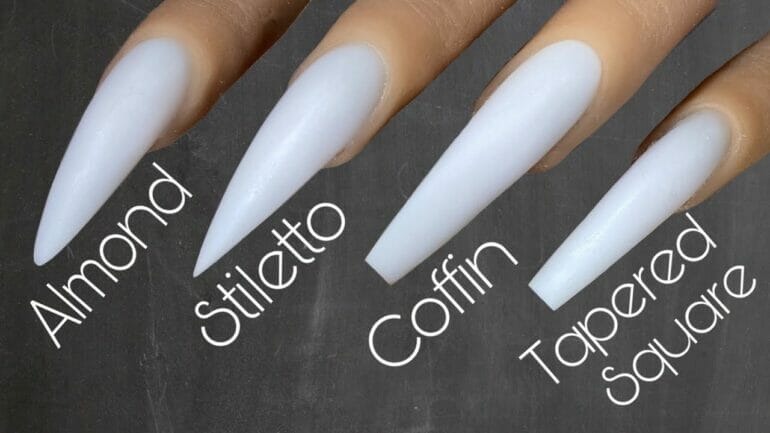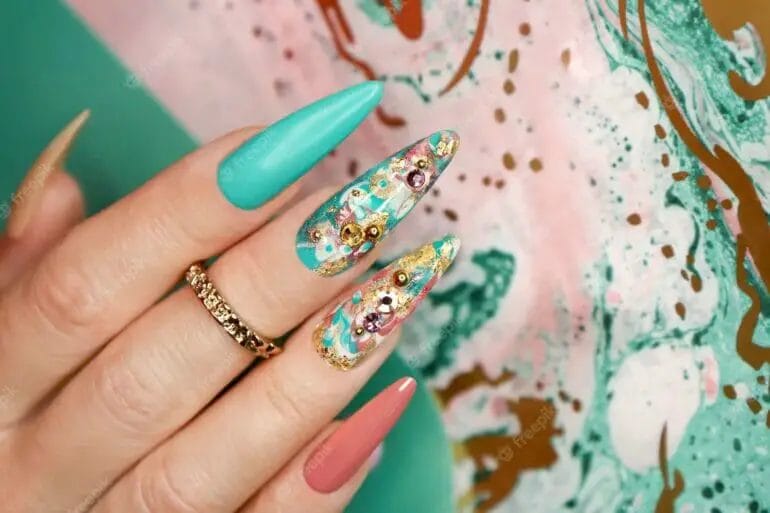When it comes to acrylic nails, thickness is a matter of personal preference and nail health. The ideal thickness of acrylic nails is typically around 1.5-2 mm. However, it’s important to consider the natural nail strength and lifestyle factors. Too thin acrylic nails can break easily, while overly thick ones may feel heavy and uncomfortable. Consulting with a professional nail technician is recommended to determine the best thickness for your acrylic nails.

Achieving the Perfect Thickness for Acrylic Nails
When it comes to getting acrylic nails, achieving the perfect thickness is essential for a flawless and long-lasting manicure. The thickness of acrylic nails not only affects the overall appearance but also determines how durable and comfortable they are to wear. In this section, we will explore the different factors that contribute to the thickness of acrylic nails and provide some tips on how to achieve the ideal thickness for a stunning nail enhancement.
Factors Affecting Acrylic Nail Thickness
Several factors influence the thickness of acrylic nails. Here are some key factors to consider:
- Application Technique: The skill and technique of the nail technician play a crucial role in determining the thickness of acrylic nails. Experienced technicians know how to create a well-balanced and evenly distributed layer of acrylic for a natural and comfortable result.
- Product Consistency: The consistency of the acrylic product used can affect the thickness of the nails. Products with a thinner consistency may result in thinner nails, while those with a thicker consistency can create a bulkier look. It’s important to choose a product that suits your desired nail thickness.
- Nail Form: The shape and length of the nail form used during the acrylic application process can influence the final thickness of the nails. Different forms offer varying levels of extension and can be customized to achieve the desired thickness.
- Client’s Natural Nail: The thickness of the client’s natural nail can also impact the overall thickness of the acrylic nail. Clients with thin and weak nails may require additional layers of acrylic to strengthen and build up the nail structure.
Tips for Achieving the Perfect Thickness
Now that we understand the factors that contribute to acrylic nail thickness, let’s explore some helpful tips to achieve the perfect thickness:
- Communicate with your Nail Technician: It’s crucial to communicate your desired thickness and nail goals with your nail technician. They can adjust their technique and product application accordingly to meet your expectations.
- Choose the Right Acrylic Product: Selecting the right acrylic product with the desired consistency is essential. Consult with your nail technician or research different brands to find one that suits your preferences.
- Consider Nail Shape and Length: Discuss the ideal nail shape and length with your nail technician. They can recommend the appropriate nail form and adjust the acrylic application to achieve the desired thickness.
- Take Care of Your Natural Nails: Maintaining healthy and strong natural nails is crucial for achieving the perfect acrylic nail thickness. Regularly moisturize your nails and avoid using harsh chemicals that can weaken them.
- Follow Proper Maintenance Routine: To ensure the longevity of your acrylic nails, follow a proper maintenance routine. Avoid using your nails as tools and schedule regular fills to keep them looking and feeling their best.
Summary
Acrylic nails can be a stylish and durable nail enhancement, and achieving the perfect thickness is essential for a flawless result. Factors such as application technique, product consistency, nail form, and the client’s natural nail all contribute to the thickness of acrylic nails. By communicating with your nail technician, choosing the right products, considering nail shape and length, taking care of your natural nails, and following a proper maintenance routine, you can achieve the ideal thickness for stunning acrylic nails that will showcase your personal style.

Expert Tips for Determining Acrylic Nail Thickness
When it comes to acrylic nails, achieving the perfect thickness is essential for both the appearance and durability of the nail. As an acrylic nail technician, it is important to have a good understanding of how to determine the appropriate thickness for your clients’ nails. In this section, we will explore some expert tips that will help you master the art of determining acrylic nail thickness.
1. Consider the Client’s Lifestyle and Preferences
One of the first things you should take into consideration when determining acrylic nail thickness is the client’s lifestyle and preferences. Some clients may prefer a thicker nail that provides extra strength and durability, while others may prefer a more natural and thinner look. Discuss the client’s expectations and lifestyle with them to determine the best thickness for their nails.
2. Assess the Natural Nail
Before applying acrylic, carefully assess the condition of the client’s natural nail. If the natural nail is thin and weak, applying a thin layer of acrylic can help provide additional strength and support. On the other hand, if the natural nail is thicker and stronger, you can opt for a slightly thicker layer of acrylic.
3. Nail Shape and Length
The desired shape and length of the nails can also influence the thickness of the acrylic. Longer nails may require a slightly thicker layer of acrylic to maintain their structural integrity. Additionally, different nail shapes, such as stiletto or coffin, may require specific thickness to achieve the desired look. Consider these factors when determining the acrylic nail thickness.
4. Nail Size and Proportions
Each client will have different nail sizes and proportions. It is important to take these factors into account when determining the acrylic nail thickness. For wider nail beds, a thicker layer of acrylic may be necessary to create a balanced and natural appearance. For narrower nail beds, a thinner layer can help avoid a bulky look.
5. Experience and Skill Level
As a nail technician, your experience and skill level also play a role in determining acrylic nail thickness. Beginners may find it easier to work with thinner layers until they gain more confidence and precision. Experienced technicians have the ability to apply thicker layers with ease and maintain a balanced and natural look.
6. Product Recommendations
Consult with fellow nail technicians or trusted suppliers to get recommendations on acrylic products that offer flexibility and strength. Certain acrylic brands may provide better control and allow for thinner layers while maintaining durability. Experimenting with different brands and products can help you find the perfect balance of thickness and performance.
7. Practice and Feedback
Lastly, continuous practice and seeking feedback from your clients will help you refine your technique in determining acrylic nail thickness. Pay attention to your clients’ satisfaction, monitor the durability of the nails, and make adjustments as necessary. Over time, you will develop a keen eye for determining the ideal acrylic nail thickness based on various factors.
Summary
Mastering the art of determining acrylic nail thickness is crucial for every nail technician. By considering factors such as the client’s lifestyle, natural nail condition, nail shape and length, size and proportions, skill level, product recommendations, and continuous practice, you can achieve the perfect thickness that not only enhances the aesthetics of the nails but also ensures long-lasting durability.

The Science Behind Optimal Acrylic Nail Thickness
Acrylic nails have become a popular choice for those looking to enhance the beauty and length of their natural nails. The process involves applying a combination of liquid monomer and powdered polymer to the nail, which forms a hard, durable layer. While acrylic nails offer numerous benefits, such as long-lasting wear and endless design possibilities, it is crucial to consider the optimal nail thickness to ensure both comfort and durability.
1. Understanding the Basics of Acrylic Nails
Before delving into the science of optimal nail thickness, it is essential to understand the basics of acrylic nails. Acrylic nails are created by combining a liquid monomer, usually ethyl methacrylate (EMA), with a powdered polymer, commonly known as polymethyl methacrylate (PMMA). This mixture creates a thick, viscous substance that can be easily applied to the natural nail.
As the liquid monomer and powdered polymer are combined, a chemical reaction known as polymerization occurs. This reaction causes the mixture to harden and bond to the natural nail, creating a durable and long-lasting artificial nail that can be shaped and customized according to individual preferences.
2. Factors Influencing Optimal Nail Thickness
Optimal acrylic nail thickness is influenced by several factors that determine the overall strength and durability of the artificial nail. These factors include:
- Nail Length: The longer the acrylic nail, the thicker it should be to maintain stability and prevent breakage.
- Nail Shape: Different nail shapes, such as square or almond, may require varying thicknesses to achieve the desired aesthetic while maintaining strength.
- Client’s Lifestyle: Individuals with more active lifestyles or professions that involve frequent hand use may require thicker acrylic nails to withstand wear and tear.
- Nail Health: The condition of the natural nails plays a role in determining the optimal thickness. Weaker or damaged nails may require thicker acrylic overlays for added support.
3. The Importance of Optimal Nail Thickness
Ensuring the optimal thickness of acrylic nails is crucial for both comfort and longevity. Too thin of an acrylic layer can result in weak and easily breakable nails, while excessively thick nails may feel heavy and uncomfortable for the wearer.
Additionally, the optimal nail thickness contributes to the overall durability and resilience of the artificial nail. Thicker acrylic layers provide a stronger foundation that is less prone to chipping, cracking, or lifting. This is especially important for individuals with active lifestyles who may subject their nails to more stress and impact.
4. Achieving the Optimal Nail Thickness
The optimal acrylic nail thickness can be achieved through proper application techniques and regular maintenance. Professional nail technicians undergo training to ensure they understand the correct ratio of liquid monomer to powdered polymer, allowing them to create acrylic nails of the desired thickness.
Furthermore, routine maintenance, such as regular fills and repairs, helps to maintain the optimal nail thickness. Over time, acrylic nails may naturally thin out, requiring fill-ins to reinforce the thickness and ensure the longevity of the artificial nails.
5. Final Thoughts
In summary, understanding the science behind optimal acrylic nail thickness is essential for both nail technicians and wearers alike. By considering factors such as nail length, shape, lifestyle, and overall nail health, individuals can achieve acrylic nails that are both aesthetically pleasing and long-lasting. Regular maintenance and proper application techniques are crucial in maintaining the optimal nail thickness, ensuring durability and comfort for the wearer.
Why the Thickness of Acrylic Nails Matters
When it comes to getting your nails done, there are many factors to consider. From the shape and color to the length and design, there are endless possibilities for customization. However, one often overlooked aspect of acrylic nails is their thickness. While it may seem like a minor detail, the thickness of acrylic nails can actually have a significant impact on their overall look and durability.
The Importance of Proper Nail Thickness
Having the right thickness of acrylic nails is crucial for several reasons. Firstly, it affects the overall strength and durability of the nails. Nails that are too thin are more prone to breakage and chipping, while nails that are too thick can feel heavy and uncomfortable. Finding the perfect balance is essential to ensure that your acrylic nails are long-lasting and resilient.
Secondly, the thickness of acrylic nails can also influence their appearance. Thicker nails tend to have a more substantial and solid look, while thinner nails can appear delicate and natural. The thickness of your acrylic nails should complement your personal style and the look you are trying to achieve.
Factors to Consider for Nail Thickness
When determining the appropriate thickness for your acrylic nails, there are a few factors to consider:
- Nail Length: The length of your natural nails can affect the thickness of the acrylic overlay. Longer nails typically require a thicker overlay to maintain their strength and stability.
- Personal Preference: Everyone’s preferences and desired nail look are different. Some individuals prefer a thinner, more natural-looking nail, while others may opt for a thicker, more dramatic appearance.
- Lifestyle: Your lifestyle and daily activities can also play a role in determining the appropriate nail thickness. If you have an active lifestyle or work in a profession that requires manual labor, thicker nails may be more suitable to withstand the wear and tear.
Consulting with a Nail Technician
Choosing the right thickness for your acrylic nails can be challenging, especially if you’re unsure of what would work best for you. In such cases, it is advisable to consult with a professional nail technician. They have the expertise and experience to assess your natural nails, understand your preferences, and recommend the appropriate thickness to achieve your desired look while maintaining durability.
A nail technician will be able to guide you through the process and help you make an informed decision. They can also provide valuable advice on nail care and maintenance to ensure that your acrylic nails remain in optimal condition for as long as possible.
In Summary
The thickness of acrylic nails is an important consideration when getting your nails done. It affects both the strength and appearance of the nails and should be carefully chosen based on factors such as nail length, personal preference, and lifestyle. Consulting with a professional nail technician can help you make the right decision and ensure that your acrylic nails are not only beautiful but also durable.
FAQs
How thick should acrylic nails be?
The ideal thickness for acrylic nails is typically around 0.04 to 0.06 inches (1 to 1.5 millimeters). This thickness ensures that the nails are strong and durable while still looking natural. However, it’s important to consult with a professional nail technician to determine the best thickness for your specific needs and desired look.
How long do acrylic nails last?
Acrylic nails can last for about 2 to 3 weeks before they need to be filled or replaced. However, the durability and longevity of acrylic nails also depend on factors such as the quality of the products used, proper nail care, and individual nail growth. Regular maintenance and gentle handling can help extend the lifespan of your acrylic nails.
Can you remove acrylic nails at home?
While it’s possible to remove acrylic nails at home, it’s generally recommended to have them professionally removed to minimize the risk of damage to your natural nails. If you do choose to remove them at home, soak your nails in acetone-based nail polish remover and gently file away the softened acrylic. Ensure that you don’t force or pry the nails off, as this can cause damage.
Conclusion
In conclusion, when it comes to acrylic nails, thickness is an important factor to consider. The ideal thickness for acrylic nails typically ranges from 0.06 to 0.08 inches. This thickness ensures that the nails are strong and durable, providing a long-lasting and natural-looking result.
However, it’s crucial to consult with a professional nail technician who can assess your natural nail health and recommend the appropriate thickness for your unique situation. Remember that overly thick acrylic nails can cause discomfort and may result in nail damage. So, opting for the right thickness is key to achieving beautiful and healthy acrylic nails.
